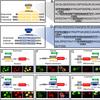Image analysis
2018
Dec
08
Nucleolar image-based screen dataset viewable online with OMERO
New automated imaging at the DRSC
. 2008. “Cellular phenotype recognition for high-content RNA interference genome-wide screening.” J Biomol Screen, 13, 1, Pp. 29-39.Abstract
. 2012. “BUHO: a MATLAB script for the study of stress granules and processing bodies by high-throughput image analysis.” PLoS One, 7, 12, Pp. e51495.Abstract
. 2008. “Identification of neural outgrowth genes using genome-wide RNAi.” PLoS Genet, 4, 7, Pp. e1000111.Abstract
. 2013. “Conserved regulators of nucleolar size revealed by global phenotypic analyses.” Sci Signal, 6, 289, Pp. ra70.Abstract
. 2010. “Inference of RhoGAP/GTPase regulation using single-cell morphological data from a combinatorial RNAi screen.” Genome Res, 20, 3, Pp. 372-80.Abstract
. 2011. “Comparative RNAi screening identifies a conserved core metazoan actinome by phenotype.” J Cell Biol, 194, 5, Pp. 789-805.Abstract
. 2007. “Quantitative morphological signatures define local signaling networks regulating cell morphology.” Science, 316, 5832, Pp. 1753-6.Abstract
. 2012. “Differential RNAi screening provides insights into the rewiring of signalling networks during oxidative stress.” Mol Biosyst, 8, 10, Pp. 2605-13.Abstract



